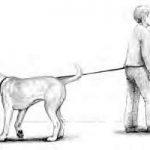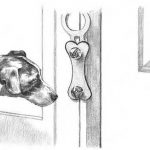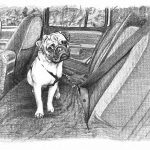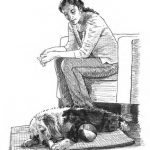- Getting ready to train
- Steps to success
- Teaching the basic commands
- Distraction proofing
- Finding a professional trainer
Part of owning a dog — and ensuring that you’re both happy — is training him. A good training regimen goes hand in hand with overall character development, good behavior, and communication. Plus, it’s fun!
In this chapter, I give you all the tools you’ll need to train your mixed breed from start to finish — from the equipment you need to the basic commands to finding a trainer to help you.
Preparing for Training
Lots of people get frustrated with training their dogs because they haven’t done some of the prep work. They just say “Sit,” shove their dog’s butt to the ground, and expect him to know what that means. If you spend just a little time getting ready to train, you’ll be setting yourself — and your mixed breed — up for success! In this section, I cover a few categories of preparation: targeting, using a clicker, and buying the right equipment.
Targeting: The first step in training
Have you ever gone to an aquarium and watched a dolphin or whale show? Did you see the sea mammals jump up and touch a big ball on the end of a long stick? That ball was called a target, and you can do the same kind of thing with your dog. Okay, so he won’t jump 20 feet out of a pool of water, but he’ll do plenty of exciting tricks of his own.
Don’t believe me? Consider this: When you give your dog a treat, does he look at your hand? That’s a target, too. A dog who watches your hand when you have a treat in it is a dog who will learn to respond to visual cues.
Targeting quickly teaches your dog what you want him to do. When you motion him to sit, he looks at your target (your hand) and sits. When you motion him to lay down (by dropping your hand downward), his nose and body will follow into position.
Here’s how to begin targeting:
1. Place a small bit of food in your hand.
Tip
When targeting, use a piece of food that has a strong smell, such as freeze-dried liver, cheese, or chicken. The enticing scent will instantly grab your dog’s attention.
2. Put your hand near your mixed-breed dog’s nose, and allow him to sniff.
3. When he puts his nose on your hand he is targeting — give him the food!
Using a marker: The second step in training
Though targeting will get your dog started on paying attention, you need a means of letting your mixed breed know that he’s doing what you want. You need to offer a specific sound or movement to coincide with the exact moment your mixed breed does what you’ve asked. This is called marking, and marking is usually done with the use of a clicker, a squeaker, or a specific word said in an enthusiastic tone of voice. The key is that the sound must be distinct from all other sounds your dog is likely to hear. For this reason, a clicker (available from most pet shops) may be your best bet.
Here’s how to teach your dog to understand a marker:
1. Begin by targeting (see the preceding section) except when your dog puts his nose on your hand, instead of giving him a treat, use your marker.
2. Then give your mixed breed a treat.
3. Repeat Steps 1 and 2 three to five times.
You can bring together the concepts of targeting and marking.
Here’s how:
1. Show your mixed breed your hand holding the treat.
2. Move your hand to the left.
3. When he moves his head to the left, mark and reward.
4. Move your hand to the right.
5. When your mixed breed moves his head to the right, mark and reward.
When your mixed breed understands the way to earn easy treats, it’s time to start making him work a little harder. Make him do more to earn his rewards — for example, move his head from side to side or up and down before you mark and reward. This is called chaining, because it’s chaining together several behaviors prior to marking the moment when your mixed breed has done what you asked. Chaining is a very important part of obedience training — you don’t want to give your mixed breed a treat for every single correct response to commands. If you do, you’ll have a very fat dog in no time!
Buying the right training tools
So many tools, so little time! With all the collars, leashes, harnesses and other paraphernalia, how will you know what’s right for your mixed breed?
The collar your dog wears while he’s lounging around the house isn’t the collar you’ll want to use when you’re training. Here’s a breakdown of which collars I recommend for training:
– Gentle Leader Easy Walk Harness: The Easy Walk Harness is a great training device for young dogs, small dogs, and dogs who don’t tend to pull hard at any time. You attach the leash to the front ring (at the dog’s chest). When the dog moves ahead, you turn and pull the leash to the side opposite where your dog is heading. Dogs acclimate quickly to this device.
– Head halter (such as Comfort Trainer and Halti): Head halters are great for dogs who pull, especially when they’re distracted. They’re also great for dominant dogs who feel it’s their duty to lead you. Several brands of head halter are on the market, but the ones I recommend are Comfort Trainer and Halti, because they don’t put pressure on the dog’s nose unless you apply it to get your dog’s attention.
The type of leash you use when you train your dog is very important. You want to use one that’s right for your mixed breed.
Tip
Never use an extendable/retractable leash — whether you’re training or not! These leashes teach your dog to pull, because the leashes are constantly trying to retract as your dog moves away from you. You want to teach your dog to pay attention and remain at your side, so this is the last thing you need.
The leash that’s right for your dog has a lot to do with your dog’s weight. Here’s a breakdown:
– 10 pounds or less: A light nylon or cotton leash no more than 1⁄4-inch wide, with a very small clip.
– 11–25 pounds: A leather or cotton leash no more than 1⁄2-inch wide with a small clip.
– 26–55 pounds: A leather or cotton leash no more than 1⁄2-inch wide with a medium clip.
– 56 pounds or more: A leather leash no more than 5⁄8-inch wide with a medium clip.
Remember
It’s not the clip that will keep the leash on your dog — it’s your training method. When using a head halter, use a lightweight leash so as not to apply any pressure to your dog’s nose without your needing to do so.
Making your voice and body work for you
Your dog will be watching everything you do and listening to every sound you make. In order to make sense to your mixed breed, be consistent with all your vocalizations and body language. This will help him understand what you want.
Tip
Use three distinct vocal tones, depending on what you want to communicate:
- Praise: A high, happy tone
- Command: A demanding, even tone
- Reprimand: A low tone
Your voice isn’t the only way you communicate. Your dog also picks up on your body language. The bigger you make yourself, the more your mixed breed will pay attention and listen to your commands. The smaller you make yourself, the less he’ll respond to your commands. The reason: A dominant dog will make himself look bigger, and a submissive dog will make himself look smaller. Most dogs won’t listen to someone they feel superior to. But they will respond quickly to someone they respect.
Tip
When giving a command, stand up straight, as shown in Figure 11-1. When rewarding or greeting your dog, crouch down, as shown in Figure 11-2.
Figure 11-1: Stand upright when giving a command.
Figure 11-2: Crouch down when rewarding or greeting your dog.
Heel
Heeling means that your dog is at your side, shoulder even with your leg. He can walk on your left or your right, whichever is most comfortable for you.
Most professional trainers and those who show dogs keep the dog on the left; in this chapter, I address the training techniques assuming that you’ll be teaching your mixed-breed dog to work on your left side, too.
The method you use for teaching your mixed-breed dog to heel depends on his age, size, and how easily distracted he might be. A young pup, for example, should be started either off-leash, or with a light leash dragging from a harness or flat neck collar. A dog older than 4 months old will need a training device, such as an Easy Walk Harness, with a light leash attached and held in your right hand. A dog over 4 months with high reactivity needs a head halter.
Getting started: The basics of Heel
Tip
Start by holding the leash loop in your right hand along with your clicker (if you’re carrying one). Have a pouch filled with treats clipped on to your jeans or tied around your waist. Hold a treat in your left hand — your target hand.
Get your mixed breed’s attention by targeting and marking (see earlier in this chapter). When he’s paying attention to you, hold your left hand (target hand) on your left thigh. Your mixed breed will move closer to your left thigh, which is heel position. Both of you will be facing the same direction.
Take a step forward as you say your mixed breed’s name and the command, “Heel” or “Let’s go” in a commanding tone of voice (see Figure 11-3). Remember: You don’t need to be loud — dogs hear far better than humans do. Demand, don’t ask.
Because the target went forward a bit as you took a step, your mixed breed is likely to follow along, his nose on your hand. As he moves with you, mark after his correct response and reward.
The next time, take two steps, then three, then four, and so on until your mixed breed is walking with you across the yard or down the sidewalk, nose on your left hand the whole way.
Figure 11-3: Have your dog target on your hand as you take a step forward.
Remember
The best means of ensuring your dog knows you are giving him a command is to precede it with his name. Use a happy tone when saying his name so that he’ll have positive associations when hearing it. In the beginning, it’ll help to give him rewards every time he looks at you when you say his name.
Tip
If your mixed-breed dog begins to move ahead of you, it means one of two things:
– You’ve walked farther than he’s ready for. To remedy this situation, just decrease the number of steps you take between marking and rewarding.
– He no longer thinks that the treats are as valuable as that squirrel he sees climbing a nearby tree. If this is the case, the moment you see his ears in front of your left leg, turn right and make a total 180-degree turn, without looking at or waiting for him.
If your mixed breed moves off to your right — say, something grabs his attention on that side, or he smells something in your right hand — turn left. As soon as you make that 180-degree turn to the left, he’s back on your left side watching you. Mark his good behavior, stop, and give him a small piece of treat.
When you’re having trouble getting your dog’s attentionOf all the obedience exercises in which you might be using a head halter, heeling differs the most from using any other training device. You may pull a bit with a body harness or flat collar — you don’t do that with a head halter. A head halter is on the dog’s head, so if you pull back, you’re turning your dog’s head and straining his neck. The best way to regain your dog’s attention while walking is to gently pull downward as you turn right (see the figure). This will turn your dog’s head toward you while also making his body follow along — without causing neck strain or injury. Pulling down with a head halter does several things: – It grabs your dog’s attention quickly in a way he understands.
– It causes your dog to be submissive to you as you press on his nose.
– It brings his entire body around to where you are.
|
Trying the Heel off-leash
When you and your mixed breed are walking along nicely, you can begin doing so off-leash indoors or within a small, securely fenced area where there are no distractions.
Working off-leash is generally the ultimate goal of many dog owners. It takes lots of time and energy, but it is possible. I’ve broken this difficult process into two phases.
Tip
You know you’re ready to begin off-leash heeling when you hardly have to use the leash at all. You can accomplish this by varying your pace, performing quick 180-degree turns, and never stopping to see what your mixed breed is up to if he’s lagging behind.
Remember
The more turns you do, the more attentive your dog.
Phase 1: Dragging the leash
While you’re walking, your mixed breed should be watching you attentively and keeping pace with you. If he’s doing so nonchalantly, drop your leash. If your dog moves a little ahead, you can quickly step on the leash with a verbal reminder that he’s not paying attention. This should be enough to return your mixed breed to your side and resume watching you — if not, return to the previous phase and work a little longer before trying this again.
Phase 2: Using a pull-tab leash
A pull-tab leash (shown in Figure 11-4) is a very short leash attached to the training device (at this point the training device should be a flat collar, because your dog no longer needs to be physically redirected).
Begin walking with a light hold on the end of the pull tab. As your mixed breed remains attentively at your side in heel position, let go. Keep a close eye on your dog. If he begins to stray out of position, use a verbal reminder in a low tone of voice as you make a sharp turn. If your dog goes in any direction other than with you, he wasn’t ready for this phase. Return to leash dragging until you no longer have to step on the leash or use any reminders about remaining in heeling position.
Otherwise, congratulations! Your dog now heels off-leash.
Figure 11-4: A pull tab should be attached to the flat neck collar and hang no longer than your dog’s chest.
Sit
Having your dog sit on command is very important in many situations:
- He should sit for attention.
- He should sit prior to being fed.
- He should sit at your side when you stop walking.
Tip
Here’s how to teach your dog to sit:
1. Begin with a treat in your hand and target with your mixed-breed dog (see earlier in this chapter).
2. When he puts his nose on your hand, mark and reward.
3. To lure your mixed-breed dog into a sitting position place your target hand between his eyes, just out of reach of his mouth, but not out of reach of his nose.
Be sure to not hold it so high above his head that he feels as though he must jump up to reach it.
4. As your mixed breed looks upward at his target, his rear end will lower down. Mark and reward.
5. Repeat Steps 1 through 4 several times.
6. Add the verbal cue — your dog’s name and the command Sit— as you place your target hand between his eyes.
This will teach him both your word for Sit and the visual cue of your hand over his head.
When your mixed breed understands the Sit concept, add it into your heeling routines and use it anytime you want him to stay in one place for a little while. As you teach your mixed breed other commands — such as Come and Stay — you’ll want to use this all-important Sit command as part of these requests.
Down
Teaching your mixed breed to lie down on command is very important. Not only can he maintain this position for longer periods of time than a Sit or Stand, but it also places your mixed breed in a less-than-dominant position.
Because of this submissive positioning, many dogs prefer not to listen to the Down command, so you’ll need to make sure you approach it in a positive manner and enforce it using rewards. If your mixed breed sees the Down as a way to get treats and belly rubs, he’ll respond to your Down command with enthusiasm.
Before you begin, find out what your mixed breed loves above all other things. Is it a specific toy, a piece of steak, or a belly rub? Use this special reward to both lure him into the Down position and keep him there for a few seconds.
Tip
Here’s how to train your dog to follow the Down command:
1. Begin with targeting your dog into the Sit (see the preceding section). Mark and reward the moment he’s in position.
2. Place the special treat directly under your mixed breed’s nose.
3. As soon as he targets on it, lower the treat to the floor (see Figure 11-5).
Figure 11-5: Lower the treat to the floor, and as soon as your dog lies down, mark and reward.
4. As he follows with his head, mark and reward.
5. Repeat the exercise again, and don’t mark until he has lowered himself a little more.
Eventually your mixed breed will lie down completely, enabling you to reward him with a belly rub.
Remember
Your dog doesn’t have to go all the way into a down position for you to reward his initial response of lowering his head. Some dogs will go all the way, while more dominant dogs may be reticent to do so. Offer your dog a chance at success in small increments.
Some dogs are so dominant that there is no treat in existence that will get them to demean themselves by lying down at your will. This type of dog needs some gentle assistance into the Down position — but it shouldn’t be forceful or harsh. Here’s what to do:
1. Begin with your dog sitting in Heel position at your left side.
2. Try targeting him into the Down position with your right hand.
3. If he ignores your visual cue, place your left hand on his shoulders as you bring out his front feet with your right hand.
4. Apply constant but gentle pressure to his shoulders as you bring the front legs forward.
5. The moment your mixed breed’s tummy touches the floor, rub his belly and praise.
Tip
If your mixed breed weighs more than 50 pounds, you’ll want to unbalance him into the Down position. Check to see the side on which he’s placing all his weight. (Hint: It’s the hip you see the least of.) As you bring the front leg of that same side forward, apply pressure to your dog’s shoulders on the opposite side, thereby lowering your mixed breed onto his side as his tummy meets the floor.
When your dog can perform both the Sit and Down on command, you’ll be ready to teach him how to remain in these positions through the following Stay exercises.
Stay
Your mixed breed needs to learn to remain in place while sitting, lying down, and even while standing. The stand/stay is great while being examined by a veterinarian or during grooming.
Though your mixed breed can stay for a short period of time in a sit or stand, he can remain in position longer while lying down. For example, a sit/stay is great while looking both ways prior to crossing a street, or while greeting someone, but your mixed breed can’Technical Stuff remain in that position more than a couple minutes without needing to move. While in a down/stay, he can learn to remain in his bed while you’re eating dinner, visiting with guests, watching television, or allowing a young child to touch him.
There are three components to teaching a solid stay:
If you teach your mixed breed with this methodical technique, he’ll learn to remain in place regardless of distractions or environmental situations, such as at a dog park, when greeting a guest at the door, or in the presence of other animals.
Time
Wouldn’t it be great if your mixed breed remained in the same place for upwards of a minute? In this section, I show you how you can get him to do exactly that.
Begin by doing this in a sit/stay.
1. Have your dog heel and sit at your side.
Tip
Always begin a training session with something that your dog knows well and will receive rewards for performing.
2. As your dog is sitting, target in front of his nose with one hand as you use a specific visual cue with the other hand.
I always use an open-fingered hand, with the palm facing the dog (see Figure 11-6).
3. Hold the target by your mixed breed’s nose for only a couple seconds.
4. Mark and reward, then continue heeling.
Figure 11-6: Hold the hand target in the same position as you did with the Sit target while giving the visual cue for stay.
With each successive Stay exercise, hold the target (and thus your dog’s attentive sit/stay) a couple seconds longer.
The next step is to add the actual Stay command. Your mixed breed already has an idea of your visual cues for the command, so he’ll easily learn the verbal ones associated with your body language. Say your dog’s name and the command “Stay” as you give the hand signal in front of his face.
Remember
You don’t need to actually touch your dog’s nose with your visual cue. Seeing it is enough. Also, don’t swing your hand toward his face. He might flinch at the motion, making the entire learning process less positive.
Tip
If your dog is getting up after a specific amount of time — for example, after he’s been staying for 10 seconds — back up a bit (say, to 8 seconds). Work at this level for the remainder of the training session. During the next session, after he’s been successfully staying for 8 seconds, try again for 10 seconds. Sometimes you’ll have more success with an exercise if you’re willing to regress a bit to a comfortable point.
When you’ve accomplished at least a 30-second sit/stay, do the same exercise with the down/stay.
If your mixed breed has trouble remaining in position, even with his target nearby, apply a light pressure to his shoulder blades any time he starts to push upward. This pressure will maintain his position without your having to replace him with another command or offering another treat.
Movement
Now that your mixed breed can remain in both the sit/stay and down/stay positions, it’s time to move around him while he stays.
As with the time factor (see the preceding section), movement should be done in small increments.
Tip
When moving around your dog in a sit/stay, begin by moving in front of him. When moving around your dog in a down/stay, begin by moving along his side and then behind him.
Here’s how to progress with a sit/stay:
1. Step directly in front of your mixed-breed dog as you give the stay command (see Figure 11-7).
2. After remaining in front of your dog for up to 30 seconds, return to the heeling position, mark his good behavior and reward him.
3. Move side to side in front of your mixed breed as he remains in his sit/stay.
Figure 11-7: The first move during a sit/stay should be directly in front of your dog, standing face to face and toe to toe.
4. When your mixed breed can maintain a sit/stay with you moving in front of him, begin walking along his sides.
Be sure to go along both sides equally.
5. Walk completely around your dog as he stays.
As with moving along his sides, do your circles around him in both directions.
Distance
The final step of the Stay exercise is to increase your distance as you move around your dog. This will allow you to tell your mixed breed to stay even if you’re not right by his side. You can do this when you’re going to answer the door, when you’re walking through gates, or when you’re going into one room and wanting him to stay in another.
As with the movement part of this exercise (see the preceding section), increase your distance using small increments and always be ready to shorten your distance if your dog can’t remain in place.
Begin with gaining 1 foot of distance as you move around your mixed breed. When he proves reliable with this, go to 2 feet, and so on, until you’re walking around him at the end of a 6-foot leash. When your mixed breed proves reliable at 6 feet, put on a 15- to 20-foot leash and gradually increase the distance even more.
Remember
Increase distance gradually. Sudden distance will cause your dog to move out of position.
Tip
Don’t move straight backward. Your mixed breed will have a tendency to move toward you if you do this. Increase your distance as you move around him.
Come
Of all the obedience exercises, having your dog come when called is probably the most important. Nothing is more frustrating than calling your dog and seeing him run in the opposite direction. Your mixed breed is not doing this because he’s vindictive — he just doesn’t understand what you want.
If you’ve already taught your dog the commands earlier in this chapter, you’re already well on your way to having your dog listen to your Come command.
The basics
As with all new exercises, start by being very close to your mixed breed so he’ll always be successful and see the come command as very positive.
1. Say your dog’s name.
2. Mark and reward when he looks at you.
3. Repeat several times.
You’ll begin noticing a few things. First, your dog not only turns to you, but he’s starting to come to you. Second, he’s doing so without any force from you — he wants to come.
Now start moving with the request:
1. Begin with targeting.
2. Back up a couple steps and have your mixed-breed dog target.
3. Back up a couple more steps and tell your mixed-breed dog his name and the command Come as you back up.
4. Repeat until you can back up at least ten steps and your dog is near your toes all the way.
Taking it up a notch: A game of Round Robin
After your dog has mastered the preceding exercises, it’s time to play a game of Round Robin. This game is a great way to teach a young dog to come when called. It’s also fun for older dogs and especially great at teaching your mixed breed to listen to the entire family.
Before you begin, make sure that everyone who wants to play the game does the earlier exercise of targeting and saying your dog’s name. This teaches your mixed breed that he’s rewarded for listening to everyone, not just to you.
Here’s how to play:
1. Have everyone stand in a circle, about 8 feet from each other.
Your dog needs some space to move from person to person.
2. Lean forward, show your mixed breed the target, say his name, and tell him, “Come” in a very pleasant tone of voice.
3. As he moves toward you, praise enthusiastically the entire time he’s coming.
4. As soon as he arrives, mark and reward.
If you’ve been using a clicker, everyone in the game must have a clicker, too. If you’re using a verbal sound, make sure everyone can emulate the sound.
5. Repeat Steps 2 through 4 with everyone in the group.
Tip
Alternate the order in which each person calls your mixed breed, so he never knows what’s coming next.
You can vary this game by adding other command elements, such as having your mixed breed sit when he arrives. Or have him lie down. Then add a stay. This way, everyone in the family will be giving him commands, and he’ll think it’s all a big game and loads of fun to listen. After all, he’s earning loads of rewards and attention. What’s not to like?
Getting your dog to come from a Stay
Now that your mixed breed is readily coming from one person to another and to you as you move backward, it’s time to try the come from both the sit/stay and down/stay.
The most difficult part of this command is gathering the leash as your dog nears you. If you don’t gather it, the leash gets entangled under your mixed breed’s feet, and disentangling it after his arrival is inconvenient for you (and annoying to your dog).
Tip
Try to gather your leash hand over hand as your dog comes to you. Don’t pull on the leash — you want your mixed breed to come when called without needing any force.
Here’s the step-by-step approach:
1. Place your dog in a Stay.
2. Lean forward, show him your hand target, hold the target near your knees, and call him to you (see Figure 11-8).
3. As your dog comes to you, stand upright and gather your leash hand over hand (see Figure 11-9).
Practice calling your mixed breed from all directions — in front of him, from each side, and from behind him. This will teach him to come from any direction. Also be sure to have your mixed breed perform the come from both his sit/stay and down/stay positions.
Remember
The more you vary the exercises, the more attentive your mixed breed will be.
Always begin with the former exercise of calling from the end of a 6-foot leash. But when your mixed breed is reliably responding, you can attach a 15- to 20-foot leash and work from greater distances. Keep in mind that the longer the leash, the more you must gather as your dog comes to you. Also, the farther away your dog when you call him, the faster he’ll move toward you — often faster than you can gather the leash! No worries: If your mixed breed arrives before you can totally gather the leash, do the following:
1. Take hold of the leash near his collar, giving him at least 2 feet of slack between his collar and your hand.
2. Move into the heel position, allowing the leash to drag behind your dog as you walk.
3. Gather the leash while you’re walking with your dog.
It will be easier to gather since your dog won’t be sitting on part of it.
Figure 11-8: Keep your upper body low and target near your knees as you call your dog to you.
As with gaining distance on the Stay exercises, you want to build on success with the recall as well. Begin with short distances and, as your mixed breed becomes reliable, gradually increase the distance as you vary the location. Practice calling him to you from in front of him, from either side, and from behind.
Tip
If you get to a specific distance and your mixed-breed dog is sniffing on his way to you, go back to a shorter distance. Your mixedbreed dog is showing you that he’s not ready for that distance yet.
Figure 11-9: As you gather your leash, move your upper body upright.
When your mixed breed is easily coming to you from the distance of the long leash, it’s time to move away from the leash a bit. Here’s how to do it in safe phases:
1. Drop the leash and move around your dog, but return to the end of the leash prior to calling him.
This will allow you to pick up the leash and guide your mixed breed to you if he gets distracted by something along the way.
2. Call him from near the leash, but not in a direct line with it.
Again, this will allow you to reinforce your command fairly quickly if your mixed breed gets distracted by something else.
3. Move farther and farther from the line of the leash as your mixed breed proves reliable.
4. Gain distance from your dog as he proves reliable from any location.
5. Hide behind solid objects so your dog learns to stay and come when you’re out of sight.
Tip
You may want to have someone help you with this because you won’t be able to see when your dog moves before you call him.
Dealing with Distractions
Maybe your beautifully trained mixed breed does super when he’s in your house or yard, but not so well walking down the road. But what if you want to be able to go places with your dog and have him still reliably follow your commands?
Your mixed-breed dog must learn how to behave regardless of where he is and what’s going on around him. This is a very important part of obedience work. Time for distraction-proofing!
Looking at the different levels of distraction
Every dog is an individual, and that isn’t more true than with a mixed-breed dog. Some dogs are distracted by the smallest leaf; others won’t react unless they see another dog coming toward them. You’ve spent some time with your mixed breed, so you probably have a sense — or are starting to get one! — of what grabs his attention.
The things that attract a dog’s attention do have some connection to the dog’s breed. If you know your dog’s mix (or you can make an educated guess), check out the following and see if any of this rings true:
– Sporting: Smells of other animals, movement of small animals or toys
– Hound: Smells and, for sighthounds, quick movements
– Working: Movement of other animals or toys, presence of a dominant dog
– Terrier: The presence of squirrels, rabbits, cats, and other dogs
– Toy: Other dogs
– Non-Sporting: Just about anything — all of these breeds are based on dogs from the other groups, so there’s no telling what will distraction them
– Herding: Movement of other animal and young children
Although specific breeds (or breed mixes) have a tendency to react more to one type of distraction than to another, a few generalizations can be made about what is least likely to distract any dog and what is most likely to distract. Here’s a list of the top-ten distractions, starting with the least likely and ending with the most likely:
- Fallen leaves
- Toys lying around
- Toys being thrown around
- The presence of people
- People moving by quickly
- Children playing nearby
- Children running near and going by quickly
- Dogs barking in a nearby yard
- Dog being walked nearby, especially if coming toward you
- Dog playing with a ball nearby
When working on distraction-proofing your dog, begin with the things like fallen leaves and toys on the floor and gradually work your way up to dogs walking or playing nearby.
Introducing distractions to your dog
Distraction-proofing is far more difficult than teaching the basic commands. It’s tough for your dog to pay attention when he’d rather be chasing squirrels, playing with other dogs or racing around the schoolyard with all the children.
Tip
You have to offer your mixed breed a positive experience for him to want to work for you amid all these distractions. In order to maintain his positive attitude, you must always have a positive outlook and offer him high-value rewards so that paying attention to you is more important to him than anything else. You’ll also need to reward him very often, so that he has more desire to pay attention.
Be prepared to redirect your dog when there is a distraction too enticing to ignore. Often treats or favorite toys can’t compete with the presence of another dog, especially one playing nearby. Your mixed-breed dog won’t care if you put a piece of steak under his nose — he feels that the better reward is to go play with that other dog. When this occurs, you need to be able to redirect him. You’ll need training tools, namely the head halter.
Here’s the process:
1. Have your dog heeling at your side.
2. When you see the distraction, don’t react — save your reaction for when your mixed-breed dog begins to look.
Tip
Don’t wait for your mixed breed to pull before you react. If he even looks at the distraction, he’s distracted.
3. When your dog notices the distraction, pull downward on your leash as you turn.
4. Continue walking until your dog is heeling properly.
5. Mark and reward.
6. Turn and try to get a little closer the next time.
Continue with your turning and redirection when your mixed breed begins to look at the other dog. Always mark the moment he returns to his correct behavior and reward him for it.
Tip
If you’ve been trying to get just a couple feet closer than the previous attempt and your mixed breed simply won’t allow that, it’s time to back off to a safer zone. For example, say you’ve been working on getting within 20 feet of that yard where the dog is barking and jumping on the fence, but your mixed breed wants to lunge toward the other dog the moment he lays eyes on it. It’s time to go back to the area where dog didn’t react so adamantly. Work in this area for a while. Then, when your dog is calm and not pulling to go toward the distraction, try to get just a few feet closer.
Helping your dog be reliable off-leash
Warning!
Don’t attempt distraction-proofing off-leash until your dog is totally reliable on-leash without your having to redirect, back off, or pull on his collar. When you’re off-leash, you can’t control your dog’s reaction. If he sees something enticing, he may not heed your words of warning.
As you reach a point in your training when your mixed breed is reliable on-leash, without any instances of having to redirect or regress, try working around the distractions off-leash. Begin with the items that are the least likely to cause him to react, such as toys lying around, the presence of another person or child, or someone moving around him. If he handles these well, try working with him near a yard where there’s another dog. Finally, with all the other distractions controlled, it’s time to attempt the most difficult: dog and toy together.
You may want to have your mixed breed wear a short leash — a pull tab, so that you have something to grab if he decides to look at the distraction instead of you. A light tug of redirection might be enough to remind him that you have far better rewards for him than that distraction does.
Finding a Trainer
Every dog is different, and many mixed breeds bring with them a whole lot of baggage. Negative experiences your dog has had in the past may cause any number of abnormal reactions, so if you’re having trouble with training, you’ll want to work with a professional trainer.
You need the help of a pro when:
– You’ve tried to train your dog, but you aren’t pleased with the response.
– Your dog continues to disobey no matter how consistent you’ve been.
– Your dog is very distracted by other dogs or people.
– Your dog has bad habits that are difficult to cure, such as housetraining accidents, excessive chewing, excessive barking, or mouthing.
– Your dog shows signs of aggression, such as dominant posturing, staring you in the eye for long periods, being pushy to get what he wants, barking for attention, grabbing hold of you with his mouth, or biting.
– Your dog shows signs of fear, such as backing up while barking and snarling, or biting you from behind.
– You’re pulling on the leash so much that you don’t want to walk with him anymore.
– You’re so frustrated that you’re reconsidering dog ownership.
If any of the preceding applies to you and your situation, look into working with a professional trainer.
To find a good trainer, start by asking your dog’s vet and groomer. Owners of small pet shops can often recommend trainers as well. (Large, chain pet shops have their own trainers, who may or may not be what you’re looking for.) You can also locate professional trainers through the following Web sites:
– The Association of Pet Dog Trainers (www.apdt.com): This group certifies trainers through testing and education. All certified trainers take a specific number of educational credits each year so they’re current on training methods and scientific behavioral knowledge.
– The International Association of Canine Professionals (www.dogpro.org): This group includes only professional trainers who have more than five years of experience. When they say professional trainer, they mean someone whose main source of income is through training dogs. IACP also offers certification to members.
– National Association of Dog Obedience Instructors (www.nadoi.com): This group has been around longer than the first two in this list. It requires certification in Novice, Open, and Utility, among other offerings such as Agility and Rally-O in order for a trainer to maintain membership. These certifications pertain more toward showing dogs than obedience training. Someone with the knowledge needed to show a dog, however, can often help others with basic training issues.
by Miriam Fields-Babineau












































